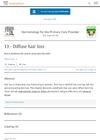Hair Loss in Infancy and Childhood
January 2019
in “
Paediatrics and Child Health
”
hair loss hair follicles hair cycle aplasia cutis congenita temporal triangular alopecia trichorrhexis nodosa telogen effluvium alopecia areata trichotillomania tinea capitis scarring alopecia British Association of Dermatologists diagnostic techniques hair biology bald spots hair breakage hair shedding bald patches hair pulling scalp ringworm scarred scalp BAD diagnostic methods hair science

TLDR The document concludes that understanding hair biology and recognizing hair conditions are crucial for managing and treating hair loss in children.
The document from 2019 provides a comprehensive review of hair loss disorders in infants and children, detailing the normal development of hair follicles and the hair cycle, as well as the diagnostic approach for pediatric hair loss. It describes various hair disorders, including congenital and acquired conditions like aplasia cutis congenita, temporal triangular alopecia, and trichorrhexis nodosa, among others. The article also discusses the clinical presentation, diagnosis, and underlying causes of these conditions, highlighting specific disorders such as telogen effluvium, alopecia areata, trichotillomania, tinea capitis, and scarring alopecia. Additionally, it outlines the British Association of Dermatologists' guidelines for managing hair loss, including the use of diagnostic techniques and treatments for conditions like tinea capitis and alopecia areata. The importance of understanding hair biology and recognizing hair conditions for proper management and treatment in children is emphasized throughout the document.






